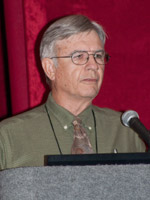General Session I
Economically Relevant Traits for Commercial Cow-Calf Production: Longevity
by Troy Smith for Angus Productions Inc.
HOUSTON, Texas (April 19, 2012) — Productive longevity is the length of time a cow remains in the breeding herd without dying or being culled. Texas A&M University animal scientist Jim Sanders says longevity might be best defined as a lack of problems. During the 2012 Beef Improvement Federation (BIF) Symposium in Houston, Texas, Sanders talked about reasons why cows leave the herd, and about selection for longevity.

Jim Sanders
“It’s easier to consider the reasons that cows are culled from the herd than it is to consider why other cows stay in the herd longer,” Sanders said. “Since different producers place different amounts of emphasis on different traits in their culling criteria, the effects traits have on longevity differs between operations. Also, different environments and management can affect the ability of a cow to remain productive.”
Sanders cited some of the culling criteria producers adopt, including poor reproductive performance, worn or lost teeth, udder or eye problems, lameness or skeletal unsoundness. A cow might be culled due to the death of her calf or because she produced one or more poor-doing calves. And age of the cow might be the reason, independent of other factors. Sometimes, reasons for culling are interrelated.
According to Sanders, genetics may influence the age at which tooth wear or loss occurs, and udder characteristics also may be related to genetic differences. And while genetic differences affect fertility, reproductive performance is often related to nutrition. Sanders said raising heifers in the same environment in which they will live their productive lives helps promote longevity. However, improvement through genetic selection is difficult due to the low heritability of longevity.
Sanders said that doesn’t mean there are not large average genetic differences between different breeds or crosses for traits that are low in heritability. There can also be large genetic differences between individual animals within a breed for traits that are low in heritability, but it is difficult to make genetic improvement based on individual animal performance.
“It has been stated that most of the “fallout” has already happened by the time a cow is 4 years old. That is, if a heifer gets bred as a yearling, breeds back as a 2-year-old and again as a 3-year-old, most of them will stay productive up until about 10 years of age. If all cows are culled that fail to wean a calf, genetic prediction based on the proportion should be effective in increasing the proportion that stay productive to 9 or 10 years of age,” Sanders said.
“The differences among breeds and crosses in their ability to stay productive to more advanced ages indicate, to me, that even more can be done if we place enough emphasis on longevity,” he added.
Sanders recommended the strategy of using young bulls born to old cows that have thrived in the given production environment. He also advised producers to take advantage of heterosis through cross breeding.
Return to the Newsroom for links to the PowerPoint presentation that accompanied this presentation.
Editor’s Note: This summary was written under contract or by staff of Angus Productions Inc. (API). Through an agreement with the Beef Improvement Federation, we are encouraging reprinting of the articles to those who will adhere to the reprint guidelines available on this site. Please review those guidelines or contact Shauna Rose Hermel, editor, at 816-383-5270. PowerPoints are posted with permission of the presenter and may not be reproduced in whole or in part without the express permission of the presenter.
API's coverage of the event is made possible through collaboration with BIF and sponsorship of LiveAuctions.tv. For questions about this site, or to notify us of broken links, click here.
Headquartered in Saint Joseph, Mo., API publishes the Angus Journal, the Angus Beef Bulletin, the Angus Beef Bulletin EXTRA, and the Angus e-List, as well as providing online coverage of events and topics pertinent to cattlemen through the API Virtual Library.



